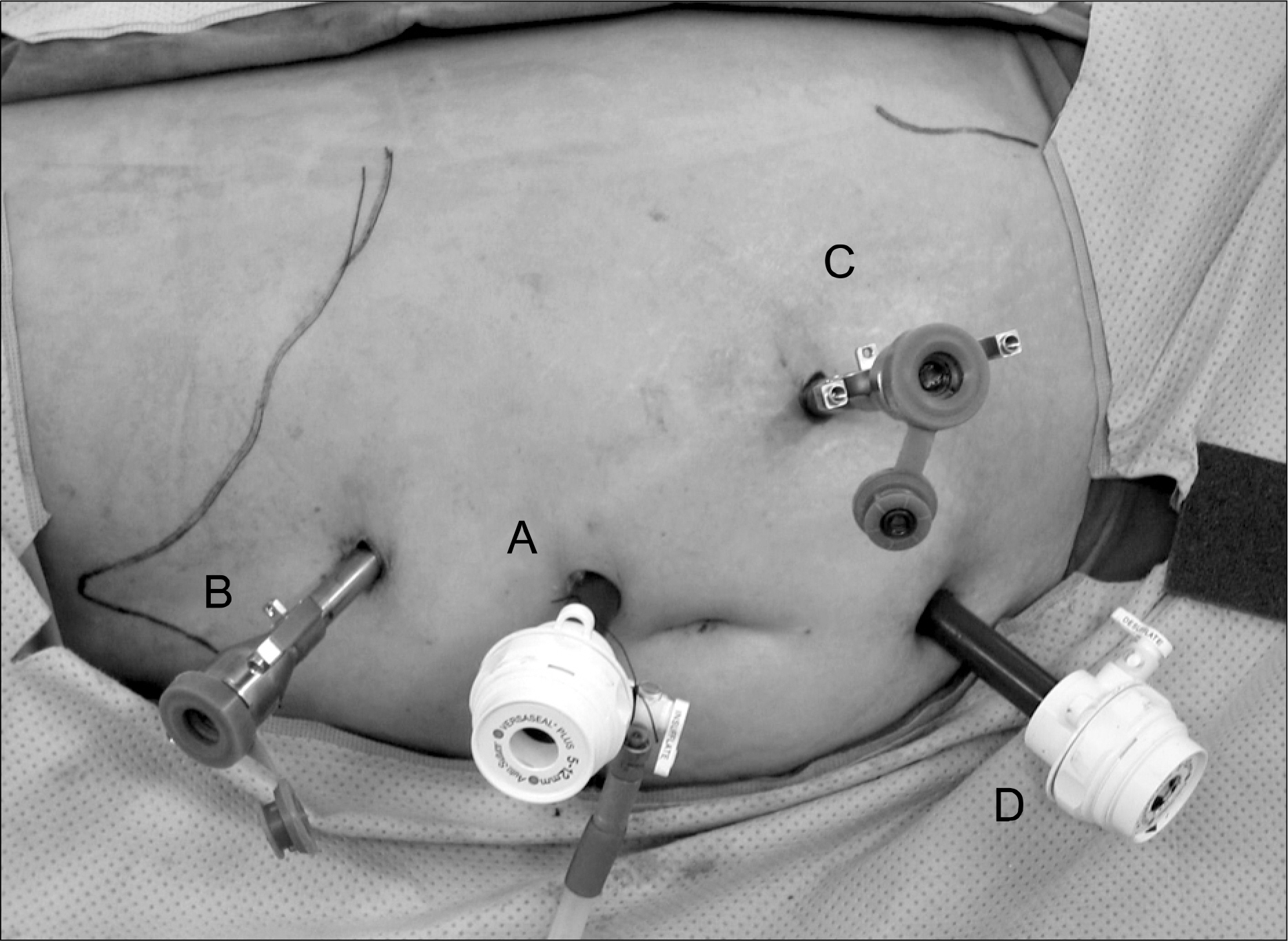Korean J Urol.
2008 Apr;49(4):373-375.
Robot-assisted Laparoscopic Nephroureterectomy with a Bladder Cuff Excision
- Affiliations
-
- 1Department of Urology, Yonsei University College of Medicine, Seoul, Korea. khrha@yuhs.ac
- 2Urological Science Institute, Yonsei University College of Medicine, Seoul, Korea.
- 3Brain Korea 21 Project for Medical Science, Yonsei University College of Medicine, Seoul, Korea.
Abstract
- We report here on our technique and outcomes of the first two cases of robot-assisted laparoscopic nephroureterectomy with a bladder cuff excision(RLNU). RLNU was performed on two female patients who both had a muscle invasive lower ureter tumor. For the first step, nephroureterectomy was performed in the lateral flank position. For the second step, bladder cuff excision and bladder repair were performed in a steep Trendelenburg position. The specimen was extracted through a 6 cm sized incision in the umbilical trocar site. Both procedures were successfully completed with using the robot without conversion to open surgery. The total operative time, including the lymphadenectomy and the robot docking times, was 320 and 241 minutes, respectively, for the 2 patients. The estimated blood loss was 40 and 200 ml, respectively. The pathological examinations showed stage T3 and T2 invasive transitional cell carcinoma of the ureter. The patients' postoperative recoveries were uneventful and the bladder cuff was free of tumor. RLNU may have potential advantages over open and laparosopic surgery due to its minimal invasiveness. This approach can be an alternative to open surgery or laparoscopic technique.
Keyword
MeSH Terms
Figure
Reference
-
1.Clayman RV., Kavoussi LR., Figenshau RS., Chandhoke PS., Albala DM. Laparoscopic nephroureterectomy: initial clinical case report. J Laparoendosc Surg. 1991. 1:343–9.
Article2.Keeley FX Jr., Tolley DA. Laparoscopic nephroureterectomy: making management of upper-tract transitional-cell carcinoma entirely minimally invasive. J Endourol. 1998. 12:139–41.
Article3.Matin SF., Gill IS. Recurrence and survival following laparo-scopic radical nephroureterectomy with various forms of bladder cuff control. J Urol. 2005. 173:395–400.
Article4.Gill IS., Soble JJ., Miller SD., Sung GT. A novel technique for management of the en bloc bladder cuff and distal ureter during laparoscopic nephroureterectomy. J Urol. 1999. 161:430–4.
Article5.Shalhav AL., Dunn MD., Portis AJ., Elbahnasy AM., McDougall EM., Clayman RV. Laparoscopic nephroureterectomy for upper tract transitional cell cancer: the Washington University experience. J Urol. 2000. 163:1100–4.
Article6.Matsui Y., Ohara H., Ichioka K., Terada N., Yoshimura K., Terai A, et al. Retroperitoneoscopy-assisted total nephroureterectomy for upper urinary tract transitional cell carcinoma. Urology. 2002. 60:1010–5.
Article7.Steinberg JR., Matin SF. Laparoscopic radical nephroureterectomy: dilemma of the distal ureter. Curr Opin Urol. 2004. 14:61–5.
Article8.Nanigian DK., Smith W., Ellison LM. Robot-assisted laparo-scopic nephroureterectomy. J Endourol. 2006. 20:463–5.
Article9.Rose K., Khan S., Godbole H., Olsburgh J., Dasgupta P. Robotic assisted retroperitoneoscopic nephroureterectomy--first experience and the hybrid port technique. Int J Clin Pract. 2006. 60:12–4.10.Nazemi T., Galich A., Sterrett S., Klingler D., Smith L., Balaji KC. Radical nephrectomy performed by open, laparoscopy with or without hand-assistance or robotic methods by the same surgeon produces comparable perioperative results. Int Braz J Urol. 2006. 32:15–22.
Article
- Full Text Links
- Actions
-
Cited
- CITED
-
- Close
- Share
- Similar articles
-
- The Early Experience of Hand Assisted Laparoscopic Surgery in Nephroureterectomy
- Robot-Assisted Laparoscopic Distal Ureterectomy and Ureteral Reimplantation
- Transitional Cell Carcinoma of Renal Pelvis Treated by Nephroureterectomy with Endoscopic Bladder Cuff Resection
- Robot-Assisted Laparoscopic Augmentation Ileocystoplasty: a Case Report
- Floating Hem-o-Lok Clips in the Bladder without Stone Formation after Robot-Assisted Laparoscopic Radical Prostatectomy



